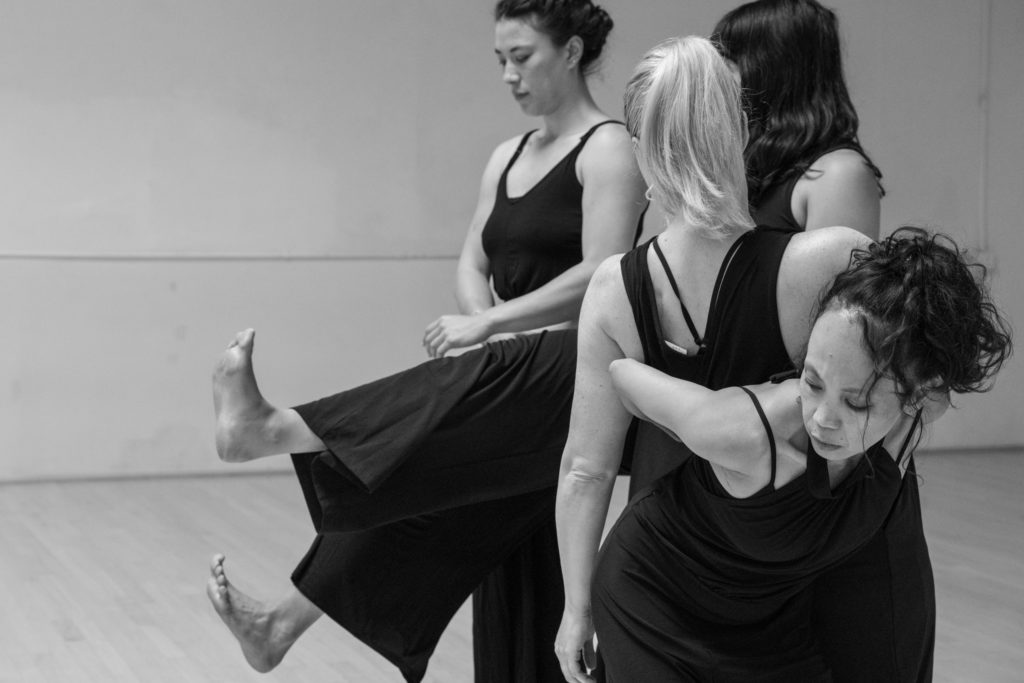Words by Maxine Flasher-Düzgünes
For most of our lives we’ve been conditioned to fear uncertainty – the unknowns where we’ll live and work, and who we’ll share it with…And certainly those external unknowns can be the most frightening – who will be our neighbour, where the protests will be, and for what reason…
And many suppress fear out of the need to avoid the “fight, flight, or freeze” response. No one has been taught to move through it, with it, and then eventually out of it. I once thought that fear indicated the danger of a situation, but I’ve come to realise it really only means that there’s a fork in the road, and that it’s the choices we make that can lead us out of danger.
In entering the labyrinthine Berkeley workspace of Nina Haft & Company, many of us encounter many forks in the road before the performance begins, the hallways of the warehouse like miniature routes pre-gaming us for the uncertainty that lies ahead.
Director Nina Haft introduces the performance as such – an improvisation – its bare-bones structure consisting of ten scores rotating among the five dancers, but that over its two-week run, no performance would be the same. She describes The Spaces Between as a way of “remaining open in a state of uncertainty” given the world’s state of chaos and how even in small ways artists must continue to move together.
As her dancers invite the audience to participate in their walking score and brief introductory conversations with one another, I sense there is no room for passivity in this space – watching is an act of being-with and does not stop when the performance ends. It becomes a sort of relation between performer and watcher that is a score all on its own.
The first dancer to take the space is Jennifer Twilley Jerum, her blond ponytail blending into the floor like sand as she billows backwards, a wave of blue longing to arrive at a place where movement is no longer strained. There is something inherently satisfying about her small dance, how its minimal beginning somehow magnetises all the unused space…and makes it precious.

Taking her place in the second score is Jesse Wiener, her hand gestures of safekeeping like some graceful conjuring of space and time. In each of her gazes upwards, I imagine a growing lust for the moon, her clothing in blue shades like the incoming darkness of night. She is joined by Frances Sedayao, also in blue, who enters riding Jesse’s back like a seahorse, sculpting her fingers along the delicate crevices of her spine. Here I sense a freed tension, the start of a partner dance and the sharing of breath as if making and remaking this unresolved ocean of what will come next. They break contact and then run around us blowing out air through their trident palms – I catch a smile and remember how we too dance in this experience, we too dance as we witness our own lives yet to be revealed.
Most scores are performed in silence, but scattered throughout are the eerie vocals of Emma Tome, like deep-sea sound waves wallowing around the dancers. In Emma’s improvisation, she reminds me of how breath is constant but contains different levels of depth – some of the time as shallow as an inch but at other times as fathomless as an underwater cave. The dancers in turn consider varying depths of choices, resulting in twists that fall or twists that balance, rolls that flatten or rolls that suspend. Like the I Ching, a Chinese classical text used for decision-making, the dancers illustrate a book of changes, each one of them pebbles free-flowing in a riptide until the moment comes to leave or stay.
Dancer Rose Huey carries a particular weight that entrances me, her cerulean harem pants riding a ripple beyond its tiny existence. Like the moment of holding before letting go, Rose extends time in her curvatures, comical yet graceful. And I wonder what tragedy there has to be in losing something when it can inevitably become something else, something round and bright and laughable at its edges. Each catch and fall between dancers is one of “i’ll still support you,” no matter how far down we go or what dark place we land. Today, I gather that everything happens unanimously, out of the need to deliver movement, but also to be set free from its obligatory structures, no regrets.
The breathy duet between Jesse and dancer Nico Ortiz Maimon seems to ask the question: what if you were my same? what if you spun my way? Their shoulder-to-shoulder centre meeting place brings me back to the image of the kid on her father’s slippers stepping to and fro, begging: dance with me. A hug from behind. A handshake-turned-floor-spin. The message is simple enough – come join in before the moment shifts and we’ve all grown up and out of our dancing shoes.
Nico concludes the series of scores with a sea-level solo, Emma’s cries tunnelling deeper into her throat, echoing bird calls. Nico’s blue garments flatten into the floor, a soft blanket to rest the body as it continues its swim toward the surface. And then gone. Every space between, replaced by the running out of time and its so-called “end.”
I think the most ephemeral part of these dances was the initial belief they could go on forever, mere distillations of ongoing moments, perhaps moments that continue to this day. What Nina has done is prolong them, for maybe a few minutes longer, into the distinct crystals that shape our lives.
To learn more about Nina’s work, visit https://www.ninahaftandcompany.com or follow @ninaotisha on Instagram.
